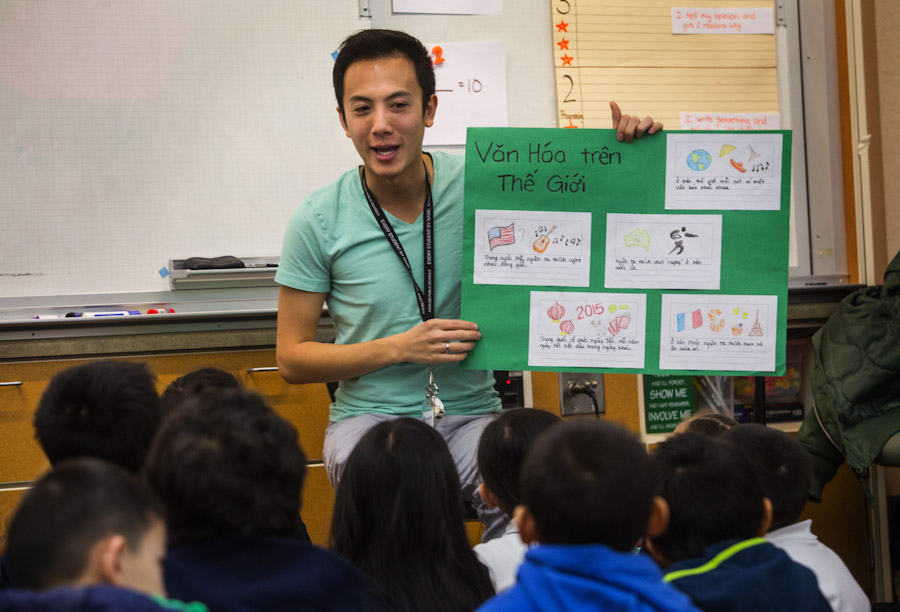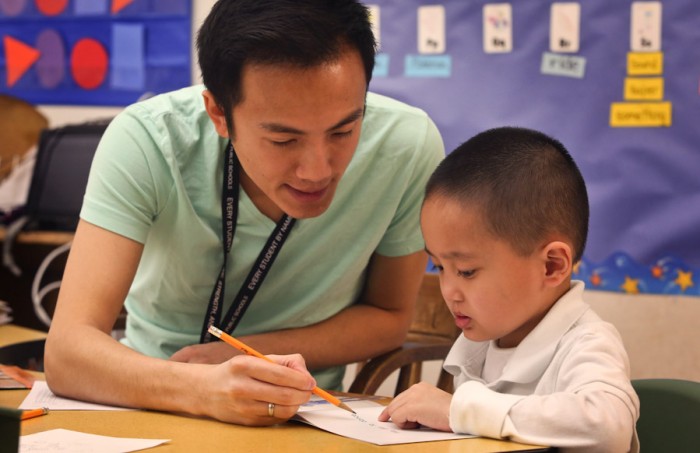
If you’re like me, any foreign language you learned in school is now a distant memory of vocabulary drills and embarrassing skits (I wrote an inspired one about riding my vélo to the boulangerie for my Ballard High School French class).
Sure, it was a daily dose of international culture, but 20 years later my language skills don’t extend much beyond a pastry case.
As the world has grown smaller, our country more diverse and language skills increasingly coveted, many in my generation feel trapped in one language or frustrated to have learned a European language when others — say Mandarin or Arabic — seem far more relevant (and marketable).
But a new Vietnamese-language immersion program at White Center Heights Elementary School in the Highline School District hopes to prove the power of dual language learning — especially when it’s done with the local community in mind.
“Biliterate and bilingual, that’s the goal,” says White Center Heights Principal Anne Reece, who considers the two teachers and 50 students in this 1½-year-old program “pioneers.”
At a glance, this pioneering first-grade class looks pretty average. There’s a wall of cubbyholes and puffy winter coats on pegs and a dozen or so students reading colorful books in miniature turquoise chairs. But then you notice that many of those books are in Vietnamese — as are the posted classroom rules.
These kids will spend half their day here and the second half in English-language classrooms.
“There are the cultural reasons, the economic reasons and the cognitive reasons,” says Highline Language Learning Director Bernard Koontz of the district goal to graduate all of its students biliterate and bilingual by 2026.
There are the jobs and the academic advantages to consider but also, says Koontz, the powerful rewards that come with teaching in a “community language” — or locally spoken language — such as Vietnamese (which is widely spoken in the White Center neighborhood).
“By valuing other languages, we just change the whole game on how we treat kids,” says Koontz, whose district is home to some of the most intense linguistic diversity in the region with what he estimates are “100-plus languages spoken.”
Of those 100-plus languages, Spanish, Vietnamese, Somali, Amharic and Punjabi top the list after English. And while there are some Spanish, Japanese and Mandarin dual-immersion programs available in other local public schools (White Center Heights has a Spanish-immersion program as well), this is the first Vietnamese program in the state.

There’s no doubt parents are interested. Koontz says there’s more of a problem with overflow than recruitment at White Center Heights, which is intended to be the first step in a program that will offer Vietnamese-English and Spanish-English dual-language learning through high school.
And, it’s important to note, not all of those eager families are ethnically Vietnamese. A quick scan of the classroom reveals students of all different backgrounds — a crucial element to the success of a dual-language program, which can run the risk of isolating or segregating certain groups of kids.
Instead, says Reece, you see the opposite.
“What I’ve noticed is once you have the language [taught] at the school it gives it social status,” she says, adding that school awards ceremonies and assemblies are conducted in English, Spanish and Vietnamese now.
That idea, of Vietnamese as a prestigious language in an American school, is exciting to Thao Tran, who teaches kindergarten in the program. Tran, who was recruited for this position straight out of graduate school at the University of Washington, grew up in a Vietnamese-speaking household but went to school in English.
“As a kid I didn’t really realize the importance of my heritage language,” she says, explaining her decision to take this experimental new job where she can teach something different to her students, “… I am here because I answered the call.”
The job is rewarding but challenging, too — it can be difficult to locate Vietnamese-language materials and to find colleagues who share the language-specific issues these teachers may face.
But it’s worth it, she says a few minutes before kids start bustling back in from recess.
Because it might be too late for Tran and me to have the bilingual education we wanted — but it’s not too late for them.

